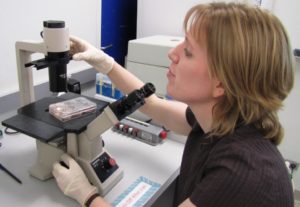
The eye’s lacrimal gland is small but mighty. This gland produces moisture needed to heal eye injuries and clear out harmful dust, bacteria and other invaders.
If the lacrimal gland is injured or damaged by ageing, pollution or even certain pharmaceutical drugs, a person can experience a debilitating condition called aqueous deficiency dry eye (ADDE), sometimes called “painful blindness”.
Now a new study in animal models, led by scientists at The Scripps Research Institute in the USA in conjunction with Flinders research, suggests that lacrimal glands can be repaired by injecting a kind of regenerative “progenitor” cell.
“This is the first step in developing future therapies for the lacrimal gland,” said TSRI biologist Dr Helen Makarenkova, who led the study.
The findings were published in the online Early Edition of the journal Stem Cells Translational Medicine.
If injured, a healthy lacrimal gland naturally regenerates itself in about seven days. When diseased and chronically inflamed, however, regeneration stops—and scientists are not sure why.
In the new study, Dr Makarenkova and colleagues, including Flinders Australian Research Council (ARC) Future Fellow Dr Robyn Meech, looked at whether they could kick start regeneration by injecting progenitor cells into the lobes that make up the lacrimal gland.
Progenitor cells are similar to stem cells in their ability to differentiate into different kinds of tissue. In this study, the researchers used progenitor cells that were poised to become epithelial tissue, a key component of the lacrimal gland.
The researchers knew they faced a major challenge: sorting and separating “sticky” epithelial cell progenitors without destroying them but researchers solved this problem by developing markers to label the cells of interest and then testing different enzymes and other reagents to draw them out of tissues.
With these cells in hand, the US researchers injected them into the lacrimal glands of mouse models of Sjogren’s syndrome, an autoimmune disease that results in ADDE, dry mouth and other symptoms. The team used only older, female mice because ADDE most commonly strikes that demographic in humans.
The treated mice showed a significant increase in tear production, indicating for the first time that epithelial cell progenitors could repair the lacrimal gland.
Further tests suggested that epithelial cell progenitors helped by restoring the connection between cells called myoepithelial contractile cells and the lacrimal gland’s secretory cells, which produce tears.
The next step in this research will be to study how long the improvement in the lacrimal gland lasts after progenitor cell injections.
Flinders Medical Science and Technology senior lecturer in pharmacology Dr Meech said it might be possible to progress the technique to clinical trials once the best source of stem cells can be identified for therapy in humans.
Dr Meech contributed to the latest lacrimal gland research by studying gene expression profiles in lacrimal gland cell populations as part of her previous studies at the Scripps Research Institute in California. She maintains close links with the US researchers on this and other stem cell-related projects.
“This latest work on the lacrimal gland is fairly novel but dry eye disease is actually quite common, especially in women as they get older, and doesn’t have any available treatments,” Dr Meech says.
View the research at Lacrimal Gland Repair Using Progenitor Cells. The research was supported by the National Institutes of Health’s National Eye Institute, the Russian Foundation for Basic Research and the ARC Future Fellowship.

